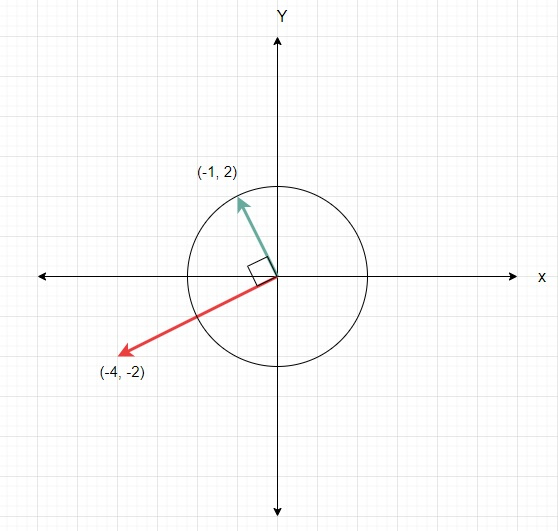
 Data Structure
Data Structure Networking
Networking RDBMS
RDBMS Operating System
Operating System Java
Java MS Excel
MS Excel iOS
iOS HTML
HTML CSS
CSS Android
Android Python
Python C Programming
C Programming C++
C++ C#
C# MongoDB
MongoDB MySQL
MySQL Javascript
Javascript PHP
PHP
- Selected Reading
- UPSC IAS Exams Notes
- Developer's Best Practices
- Questions and Answers
- Effective Resume Writing
- HR Interview Questions
- Computer Glossary
- Who is Who
Check if it is possible to reach vector B by rotating vector A and adding vector C to its in Python
Suppose we have three vectors x, y and z in 2D plane. We have to check whether we can get vector y from vector x by rotating it 90 degrees(clockwise) or adding z with it any number of times as required.
So, if the input is like x = (-4, -2) y = (-1, 2) z = (-2, -1), then the output will be True as we can add z with x to get location (-2, -1), then rotate 90° clockwise to get (-1, 2).

To solve this, we will follow these steps −
Define a function util() . This will take p, q, r, s
- d := r * r + s * s
- if d is same as 0, then
- return true when p and q both are 0, otherwise false
- return true when (p * r + q * s) and (q * r - p * s) both are divisible by d, otherwise false
- From the main method do the following −
- if any one of util(x of p - x of q, y of p - y of q, x of r, y of r) or util(x of p + x of q, y of p + q[1], x of r, y of r) or util(x of p - y of q, y of p + x of q, x of r, y of r) or util(x of p + y of q, y of p - x of q, x of r, y of r) is true, then
- return True
- return False
Example
Let us see the following implementation to get better understanding −
def util(p, q, r, s): d = r * r + s * s if d == 0: return p == 0 and q == 0 return (p * r + q * s) % d == 0 and (q * r - p * s) % d == 0 def solve(p,q,r): if util(p[0] - q[0], p[1] - q[1], r[0], r[1]) or util(p[0] + q[0], p[1] + q[1], r[0], r[1]) or util(p[0] - q[1], p[1] + q[0], r[0], r[1]) or util(p[0] + q[1], p[1] - q[0], r[0], r[1]): return True return False p = (-4, -2) q = (-1, 2) r = (-2, -1) print(solve(p, q, r))
Input
(-4, -2), (-1, 2), (-2, -1)
Output
True

Advertisements
